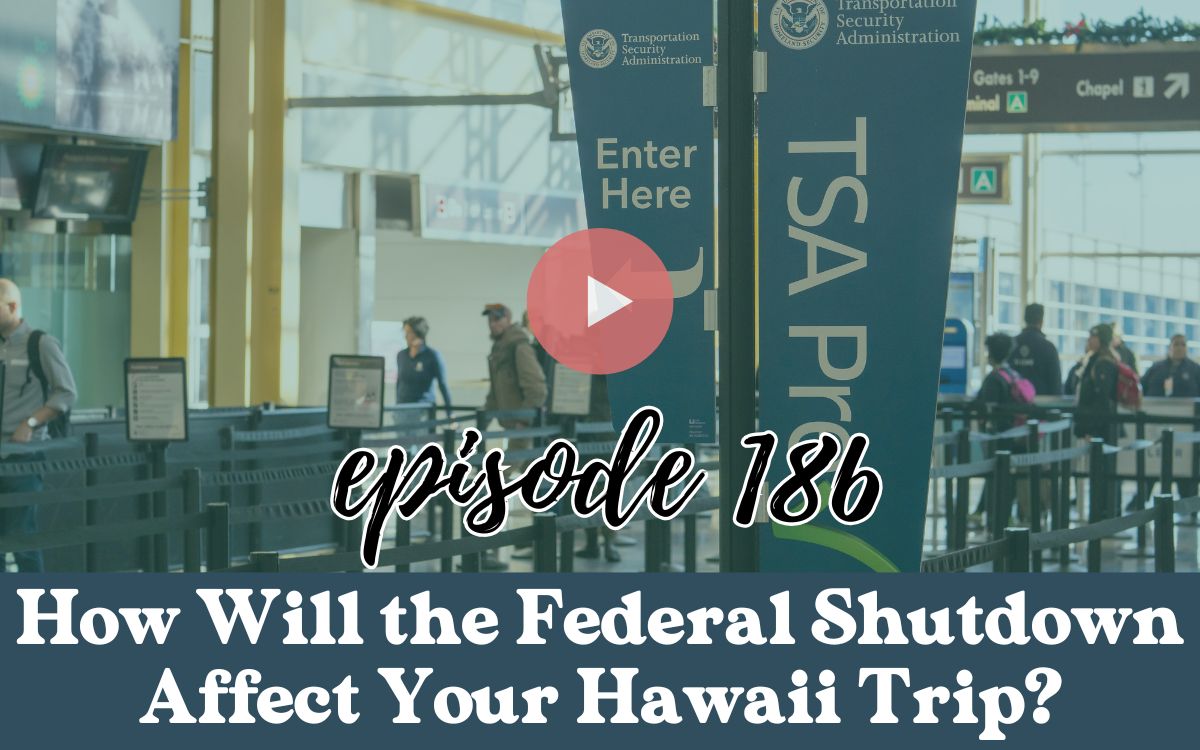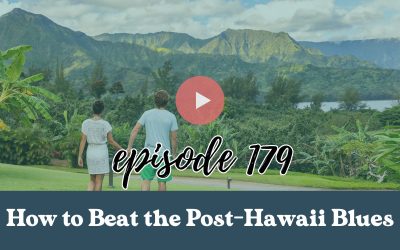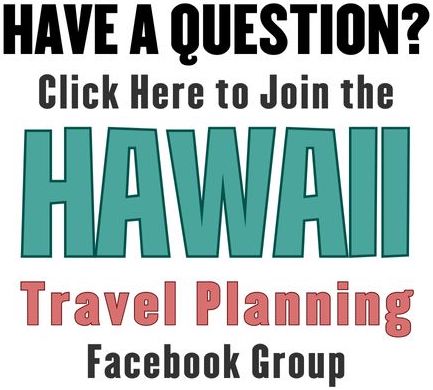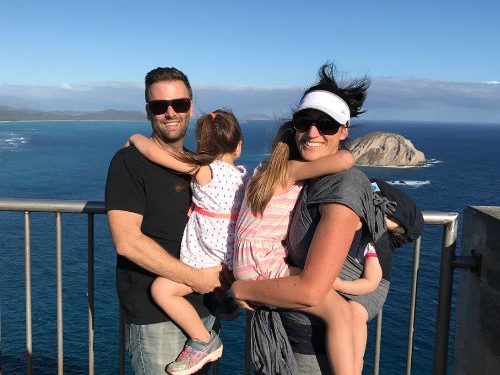How Will the 2025 Federal Shutdown Affect Your Hawaii Trip?

Will the federal government shutdown affect your Hawaii trip? That’s the urgent question thousands of travelers are asking right now as headlines create confusion about what’s actually open and what’s closed.If you’re planning a Hawaii vacation or currently on the islands, this breakdown cuts through the noise with facts, official sources, and actionable steps to keep your itinerary on track.
Love the Podcast? Join as a premium member today!
Affiliate Disclosure
This post may contain affiliate links, meaning I earn a small commission if you use the links. View our Privacy Policy and for more.
Affiliate Disclosure
This post may contain affiliate links, meaning I earn a small commission if you use the links. View our Privacy Policy and for more.
Affiliate Disclosure
This post may contain affiliate links, meaning I earn a small commission if you use the links. View our Privacy Policy and for more.
Our Favorite Hawaii Travel Resources!
🏨 Accommodations: We recommend Booking.com
✈️ Flights: For the cheapest flights, we use Skyscanner
🚗 Rental Car: We recommend Discount Hawaii Car Rental
🌋 Attractions: We recommend Viator
🌺 Luaus and Tours: We recommend Hawaii Tours
📱 Mobile Tour App: Our favorite is Shaka Guide
What the Shutdown Means for Your Hawaii Travel Plans
The federal government has officially shut down, but your Hawaii trip doesn’t have to be ruined. Most experiences visitors come for—beaches, culture, food, and the aloha spirit—remain fully accessible. The key is knowing what’s affected and having smart backup plans.
After researching official sources and comparing this situation to the 2018 shutdown (which lasted 35 days), here’s exactly what you need to know to protect your vacation.
Flights and Airports: Still Operating with Potential Delays
Good news first: Your flights to Hawaii are still running. TSA officers and FAA staff are considered essential personnel, so commercial flights continue operating on schedule.
The catch: These essential workers aren’t getting paid during the shutdown. During the 2018 shutdown, many TSA officers called in sick because of unpaid work, creating staffing shortages and longer security lines at airports.
TSA officials have already warned Hawaii travelers to expect potential slowdowns if the shutdown continues. Plan to arrive at the airport earlier than usual and monitor your airline’s updates for any delays.
What’s Definitely Open Right Now
State and county parks are operating normally. This means Diamond Head on Oahu, Waimea Canyon on Kauai, and Iao Valley on Maui remain fully accessible with regular services.
All private businesses continue as usual—hotels, restaurants, luaus, snorkeling tours, food tours, and cultural programs don’t rely on federal funding and aren’t affected by the shutdown.
Pearl Harbor’s nonprofit sites are staying open. The USS Missouri, Bowfin Submarine Museum, and Pearl Harbor Aviation Museum are managed by Pacific Historic Parks, a nonprofit organization that confirmed they’ll remain operational throughout the shutdown.
Essential government services continue running. Social Security payments, Medicare, and VA medical centers operate normally since they’re funded in advance or considered essential.
What’s Limited or Uncertain
Hawaii’s National Parks fall into a gray area. The Department of Interior’s official plan states parks will remain “as accessible as possible,” but this creates confusion for travelers.
In practice, this means you might still be able to enter parks like Haleakala National Park or Hawaii Volcanoes National Park, but visitor centers, restrooms, ranger programs, and trash collection stop unless the park has fee money to keep them running.
Pearl Harbor’s visitor center faces uncertainty since it’s staffed by National Park Service employees who are furloughed during shutdowns. Staff reportedly left work yesterday not knowing if they’d return today.
Other National Park Service sites in Hawaii—including Puuhonua o Honaunau and the Kalalau Trail—haven’t issued clear shutdown notices but expect reduced or no services based on the official plan.
What’s Likely Closed
Wildlife refuges and lighthouses that require staff for public access are closing. The Fish and Wildlife Service plan specifically states refuges close unless they don’t need staffing. This means places like Kilauea Point Lighthouse on Kauai are very likely closed.
Some trails that don’t require staffing might remain accessible, but don’t count on any facilities being open.
Learning from 2018: What to Expect
The last major shutdown in 2018 lasted 35 days and affected about 300,000 federal workers, including many in Hawaii. Travelers noticed the biggest impacts at airports and national parks.
Airport impacts: Fewer TSA screeners showed up for unpaid work, creating longer security lines and more stressful travel experiences.
Park impacts: Hawaii Volcanoes National Park stayed open to visitors but with severely cut services. Roads closed, ranger-led programs were canceled, and facilities weren’t maintained. The Congressional Research Service later reported that parks left open without staff saw trash pile-ups, closed bathrooms, and even damage to cultural and natural resources.
Pearl Harbor confusion: The mix of federal and nonprofit operations created uncertainty for visitors, similar to what we’re seeing now.
Your Action Plan for Hawaii Travel During the Shutdown
Check official sources before you go. The National Park Service Hawaii page (nps.gov/hi) and Hawaii Tourism Authority (gohawaii.com) are updating their websites with current information. Monitor these during your visit.
Create backup plans for federal sites. If you planned to visit Haleakala or Hawaii Volcanoes National Park and find limited services, swap that day for a state park or beach. Oahu has Diamond Head and Lanikai Beach. Maui offers Iao Valley. Kauai provides Waimea Canyon.
Prepare for reduced services in federal parks. If you do find gates open, don’t expect clean restrooms, running ranger programs, or trash collection. Pack out everything you bring in and bring your own water and snacks.
Book private experiences. Luaus, snorkeling trips, food tours, and cultural programs operate normally. This is also a great opportunity to support local businesses while enjoying authentic Hawaii experiences.
Stay flexible with your schedule. Build buffer time into your itinerary and be ready to reorder days if a site has limited access. The key to any Hawaii vacation is maintaining flexibility.
Arrive early at airports. Given potential TSA staffing issues, allow extra time for security screening and keep your identification and boarding passes easily accessible.
Essential Services Continue
One important clarification: despite some confusing reports, ACA (Obamacare) subsidies continue through the shutdown. The Congressional Research Service confirms that enhanced Affordable Care Act subsidies remain in place through December 31, 2025, and standard ACA subsidies are permanent.
Social Security payments, Medicare services, and VA medical centers all continue operating normally during the shutdown.
Bottom Line for Hawaii Travelers
A federal government shutdown doesn’t mean your Hawaii trip is canceled or ruined. The majority of experiences that make Hawaii special—beautiful beaches, rich culture, incredible food, and warm hospitality—remain fully available.
You may need to adjust plans for some federal sites and allow extra time at airports, but with proper planning and flexibility, your Hawaii vacation can still be everything you hoped for.
Download the complete Hawaii shutdown guide with live links to all official sources mentioned in this episode. Get real-time updates and protect your itinerary with this free resource available in the show notes.
The shutdown creates uncertainty, but it doesn’t eliminate the magic of Hawaii. Stay informed, stay flexible, and focus on the incredible experiences that are still waiting for you in paradise.
Listen On:
Episode Resources
🤙 Sources:
- https://www.hawaiinewsnow.com/2025/09/30/how-federal-government-shutdown-impacts-hawaii
- https://thehill.com/homenews/senate/5530414-government-shutdown-funding-bills
- https://www.politico.com/news/2025/10/01/government-shutdown-national-parks-00123456
- https://www.doi.gov/shutdown
- https://crsreports.congress.gov
- https://www.kff.org/health-reform/issue-brief/
- https://www.gohawaii.com
- https://www.nps.gov/state/hi/index.htm
- https://www.recreation.gov
Support the Show
Review This Podcast On:
Planning a trip to Hawaii? Join Our Facebook Group!
It’s the perfect place to ask any questions and to be inspired for your trip to Hawaii!
Transcript
How Will the 2025 Federal Shutdown Affect Your Hawaii Trip
[00:00:00] Bryan Murphy: Will the federal government shutdown affect your Hawaii trip? And that’s really the big question right now. And in this episode, we will be answering that. We’ll cover what’s open right now and what’s likely to be closed or limited, and how it could impact your reservations and travel plans. And we’ll discuss what we can learn from the last shutdown, which was in 2018, so you have a better understanding of what to expect.
[00:00:26] Bryan Murphy: Welcome to Hawaii’s Best, the podcast helping you plan an. Unforgettable Hawaii vacation with practical tips and the latest in Hawaii travel news. If you listen to the episode yesterday, I know I mentioned that I’m gonna be going back to weekly episodes during the fall, during the shoulder season in Hawaii.
[00:00:45] Bryan Murphy: Honestly, I woke up this morning thinking about you. If you are planning a trip to Hawaii, or maybe you’re in Hawaii right now, and hearing the news about the federal shutdown, I thought about. Those who are planning to travel to Hawaii. Hawaii during this time is a beautiful time. During October, I wanted to get this episode out and I’ve been researching most of the morning with UpToDate info, and I’m gonna cite all of my sources.
[00:01:12] Bryan Murphy: I’m not just gonna give my opinions here. I will interject where necessary, but I’m gonna give you facts and what is current and what we know right now. I’m gonna list all that in the show notes. This is a topic that can get political pretty quickly, and I am not gonna go down that route. I simply just want to report how this could and will affect anybody who is in Hawaii right now, especially those who are traveling for vacation.
[00:01:41] Bryan Murphy: So if you’re planning a trip right now, you’ve have probably seen the headlines, or if not, maybe this is your news source to this, but the federal government has officially shut down. It’s not the first time. We’re gonna talk about a little bit what 2018 was like and how we can learn from that and kind of expect what to expect because of that.
[00:02:03] Bryan Murphy: So what does that mean for you and your trip if you’ve got tickets to say Pearl Harbor or if you’re hoping to catch, you know, sunrise at Halakah National Park. You know, are the national parks open or are they closed? And really the honest answer right now is, well, it depends, which is kind of frustrating.
[00:02:21] Bryan Murphy: Some reports say the parks are closed, others like. One from Politicos say that they’ll stay as accessible as possible. We saw that in 2018. I don’t wanna get ahead of myself, but we’ll talk and unpack what that means and in Hawaii, Hawaii News now is reporting that the staff at Pearl Harbor walked out yesterday not even knowing if they’d be back in on October 1st, which is at the time of this recording today.
[00:02:47] Bryan Murphy: But this is coming out on the second, so if you’re wondering which one it is, you’re not alone. That’s exactly what we’re gonna be unpacking today, and we’ll start with what we know for sure today as October 1st, the first day in the shutdown, we will look at what’s likely to be limited, and finally, I’ll share what happened during the last shutdown in 2018 and how that impacted travel in Hawaii.
[00:03:10] Bryan Murphy: To make this all easy for you, I put this in an all this information condensed into a free PDF guide, and I’ll include that with live links to official sources like the National Park Service, Hawaii Tourism Authority. And so you can have all the latest updates really within that guide, and you’ll find that in the very first link in the show notes below where you can grab it after this episode.
[00:03:34] Bryan Murphy: So let’s start with the basics of what we know right now.
[00:03:37] Bryan Murphy: Well, flights are still running to Hawaii and TSA officers and FAA staff are considered essential. Thank goodness, though they’re not getting paid right now, but they’re still at their posts, and that means your flights to Hawaii or between the islands is going ahead as schedule.
[00:03:57] Bryan Murphy: Now, here’s something to kind of keep in mind. During the 2018 shutdown, a lot of TSA officers started calling in sick because, well, they weren’t getting paid. Now, when that happens in large numbers, it leaves checkpoints, short staffed, and creates long lines at the airports. So this week, TSA officials told HNN, again, that’s Hawaii news now that if the shutdown continues, travelers should be prepared for that kind of slowdown again.
[00:04:28] Bryan Murphy: What about the parks and activities?
[00:04:30] Bryan Murphy: And really the good news is that state and county parks are open, so places like Diamondhead, YME Canyon, yal Valley on Maui and the Nepal coast on Kauai are all operating normally. And same goes for your hotel restaurants, luaus and snorkeling tours, et cetera. These don’t rely on federal funding.
[00:04:53] Bryan Murphy: The Hawaii Tourism Authority even put out a reminder that state parks, beaches, and private businesses are still open. As usual, Pearl Harbor is where things. Get a little bit more complicated. It’s been really hard to try to find a straight answer. According to HNN, the center is staffed by National Park Service and those workers are furloughed during a shutdown.
[00:05:16] Bryan Murphy: What’s important to note is that the Battleship Missouri and the Boin Submarine Museum and the Pearl Harbor Aviation Museum aren’t. Federal. They’re managed by Pacific Historic Parks, a nonprofit organization, and they’ve already said that they are gonna remain open. Getting into the weeds just a little bit, because I know a lot of people who are in Hawaii listen to this podcast as well.
[00:05:41] Bryan Murphy: So for residents who depend on benefits, social security, Medicare, those are all still active. They’re considered essential. So payments keep going out. Interviews with a RP, Hawaii h and n reported that new applications and customer service could take longer than usual. VA medical centers are also open because they’re funded in advance.
[00:06:04] Bryan Murphy: Now, I wanna pause here real quick because as I was doing research, I saw on H and n, they reported about. 20,000 Hawaii residents would lose their Obamacare subsidies because the fiscal year ended. I’ve fact checked that and I couldn’t find that to be accurate. So if this affects you, this is what I found, and you can do your own research as well.
[00:06:26] Bryan Murphy: The Congressional Research Service confirms that the Enhanced Affordable Care Act a CA subsidies, which help lower premiums are in place through the end of 2025. I also found that on. The Kaiser Family Foundation, which says the same thing. So standard a CA, subsidies are permanent and the temporary enhanced subsidies don’t expire until December 31st, 2025.
[00:06:52] Bryan Murphy: So all that to say, if you know someone is on a CA coverage, you don’t need to worry, at least from my research, and I encourage you to do your own research.
[00:07:02] Bryan Murphy: Finally, probably the biggest question, let’s talk about the National parks, the Department of Interior’s official plan. Says Parks will stay as accessible as possible, and I’ll make their PDF available.
[00:07:16] Bryan Murphy: Also, somehow below in the show notes, this is what they officially put out. They’re gonna remain as accessible as possible. So in practice that means you might still be able to enter a park or walkie trail. But visitor centers, restrooms, ranger programs, and trash collections stop unless the park has fee money.
[00:07:37] Bryan Murphy: To keep them running for visitors, that often means the park won’t feel fully open, obviously, even if the gates aren’t locked. So here’s where we stand today. In all of this, flights are operating. State parks and beaches are open. Nonprofit museums like Pearl Harbor are welcoming visitors, social security, VA services, and a CA.
[00:08:02] Bryan Murphy: Subsidies continue. But Hawaii National Parks are in a great zone, accessible, but without the services most people expect. Other National Park service sites in Hawaii also fall into this uncertain category that includes p.
[00:08:21] Bryan Murphy: And the Al Kaha Kai Trail. None of these have put out a clear shutdown notice as of now. But based on the plan, you can expect reduce or no services. Just like in 2018 when some of these places were left open without staff. If you’re planning to visit a wildlife refuge, the rules change a little. The Fish and Wildlife Services plan says refuges are closed unless they don’t get staff for public access.
[00:08:48] Bryan Murphy: That means visitor centers and lighthouses like. Kilo point on Kauai are very likely close trails that don’t need staffing. Might still be accessible, but really don’t count on any facilities there to be open and really to understand what this might mean for you if you’re traveling to Hawaii or if you’re in Hawaii right now.
[00:09:10] Bryan Murphy: It helps to look back at the last major shutdown in 2018 that lasted for 35 days. That’s the longest in US history. Back then, about 300,000 federal workers were furloughed without pay, including many in Hawaii. According to HNN, travelers noticed it most at the airports, so with few screeners showing up, security lines got longer and longer, and the whole process became more stressful.
[00:09:38] Bryan Murphy: National Parks were another area where the impact showed up. Hawaii’s Volcano National Park stayed open to visitors, but services were cut. The National Park Service reported that roads were closed. Ranger led hikes and volunteer programs were canceled and facilities weren’t maintained. The Congressional research service later noted that parks left open without staff solved trash pile ups, closed bathrooms, and even damage to cultural and natural resources in Hawaii.
[00:10:06] Bryan Murphy: Pearl Harbor also showed reduced operations while nonprofit partners kept some sites open. The uncertainty around visitor centers created confusion for many travelers. Kind of what we’re seeing right now.
[00:10:17] Bryan Murphy: Alright, so kind of take a deep breath and you know, after hearing all of this, you might be wondering, what does it mean for your trip?
[00:10:26] Bryan Murphy: How do you plan with these things that feel uncertain? And you’re like, Brian, you just made. More confusing. I hope I didn’t, but this is what is current. It is confusing. Really. The first thing to check before you go is the National Park Service and Hawaii Tourism Authority are updating their websites best as they can.
[00:10:46] Bryan Murphy: So you can go to nps.gov/. Hi for Park updates or go to go hawaii.com for broader alerts. And you know, always check in monitoring those during your visit or leading up to your visit to Hawaii. And second, have a backup plan. If you’re hoping to visit Halala or Hawaii Volcanoes National Park and the visitor centers are closed, maybe swap that day for a state park or beach.
[00:11:12] Bryan Murphy: If you’re on Oahu, you got Diamond Head. Ka got Ban Canyon, Maui. You know you got Al, Al Valley. You know, all of those are open. The third thing to keep in mind is expect fewer services inside federal parks if you do get in. So if you find that the gates are open, but don’t expect restrooms to be clean, ranger programs to be running or trash to be collected.
[00:11:37] Bryan Murphy: So all the more, it’s important to pack out what you bring in the fourth thing outta five that. I hope to clear up is look, private experiences where you can, so Lou Owls, snorkeling trips, food tours, cultural programs are all operating normally. This is another great chance to support local businesses while you’re enjoying your trip and finally, stay flexible.
[00:12:00] Bryan Murphy: That’s really the key that really gets kind of the key to visiting Hawaii is be flexible. A government shutdown doesn’t mean your trip to Hawaii is. Ruined most of the experiences visitors come for, you know, the beaches, culture, food, and really the aloha spirit are still in Hawaii. You may just need to adjust if a park or visitor center isn’t open the way you expected.
[00:12:22] Bryan Murphy: And again, I have all of this info and with the live links for these official sites to stay up to date. You can just get that PDF in the show notes below first. Link and if you found this information helpful, would love it if you just took a few seconds and left a review. If you are listening on Apple Podcasts or if you’re on Spotify, just go ahead and leave a rating.
[00:12:45] Bryan Murphy: Take you a couple seconds to do that. Really appreciate it. Again, thank you for listening, and until next time, next Wednesday, unless something else comes up, I will see you then and until then. Live with Aloha
[00:13:01] Bryan Murphy: Mala for listening to this episode of Hawaii’s. Best to stay up to date on future episodes. Hit follow on your podcast app. Hawaii’s Best is a production of shore break media group with editing by easy podcast solutions and music courtesy of our friends. Stick figure.
RELATED PODCASTS
Ep. 179: How to Beat the Post-Hawaii Blues: 3 Simple Steps to Keep the Aloha Alive
Ever stepped off the plane from Hawaii and felt like you just hit a wall? You're not alone. That post-Hawaii crash is real, and it affects millions...
Ep. 178: 7 Things Not to Do in Hawaii
Planning a trip to Hawaii? Most travelers focus on what to do—booking tours, finding beaches, packing sunscreen. But knowing what NOT to do can make...
Ep. 177: Why September Is the Best Month to Visit Hawaii
Did you know most travelers completely overlook September when planning their Hawaii vacation? While everyone fights for summer dates or winter...
Bryan Murphy is the creator of Hawaii’s Best Travel and a Certified Hawaii Destination Expert through the Hawai‘i Visitors Bureau. He’s an active member of the Hawai‘i Visitors and Convention Bureau and continues ongoing education focused on Hawaiian culture, history, and sustainable travel. As the host of the “Hawaii’s Best Travel” podcast—one of the top travel podcasts in the U.S.—Bryan shares practical, respectful guidance to help visitors experience Hawai‘i in a more meaningful way. His work reaches nearly half a million people across podcast, blog, and social media.










